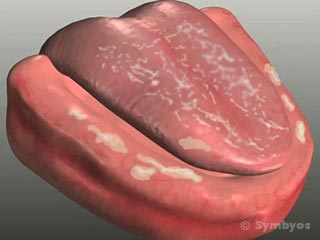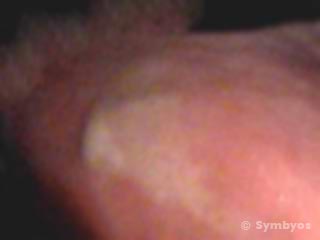Oral cadidiasis (thrush)

Whitish-gray curds and linear hyphae, which are typical of an oral fungal infection known as pseudomembranous candidiasis.
Oral candidiasis is a common fungal infection, most often found in patients who are missing all their teeth. These include infants, and patients whose teeth are congenitally missing or have been lost—especially denture wearers who infrequently remove their dentures for cleaning and soft tissue rest. It can also occur following antibiotic therapy, but less commonly in the mouth.
Most oral candidiasis is caused by the fungus Candida albicans. There are several variants. Atrophic candidiasis presents as a fiery red, bald/shiny oral mucosa which can be a very painful condition, and may represent a side effect of a more involved condition, such as diabetes or impaired immune function.

An area of pseudomembranous candidiasis on the right dorsal surface of the patient’s tongue is shown seven days into the healing process. The yellowish curd shown is typical of the condition. This patient is a diabetic who wears complete upper and lower dentures and maintains them poorly due to physical debilities of her advanced age, and dementia.
Pseudomembranous candidiasis, the classical variant, is more benign and typically presents with whitish-yellow curds on the oral mucosa which can be rubbed off (with some difficulty). The underlying soft tissue is typically bright red and very tender.
Angular cheilitis is a candida infection that occurs at the junction of the upper and lower lip (i.e. the corners of the mouth, or commissures). The condition is a common finding in patients who have lost multiple back teeth, and whose bite has collapsed (also known as loss of vertical dimension of occlusion), such that the patient’s cheeks fold over on themselves at the corners. It is also sometimes seen in nutritional deficiencies.
Candida infections in adult patients with teeth are uncommon, and should raise suspicions that the patient may have HIV.